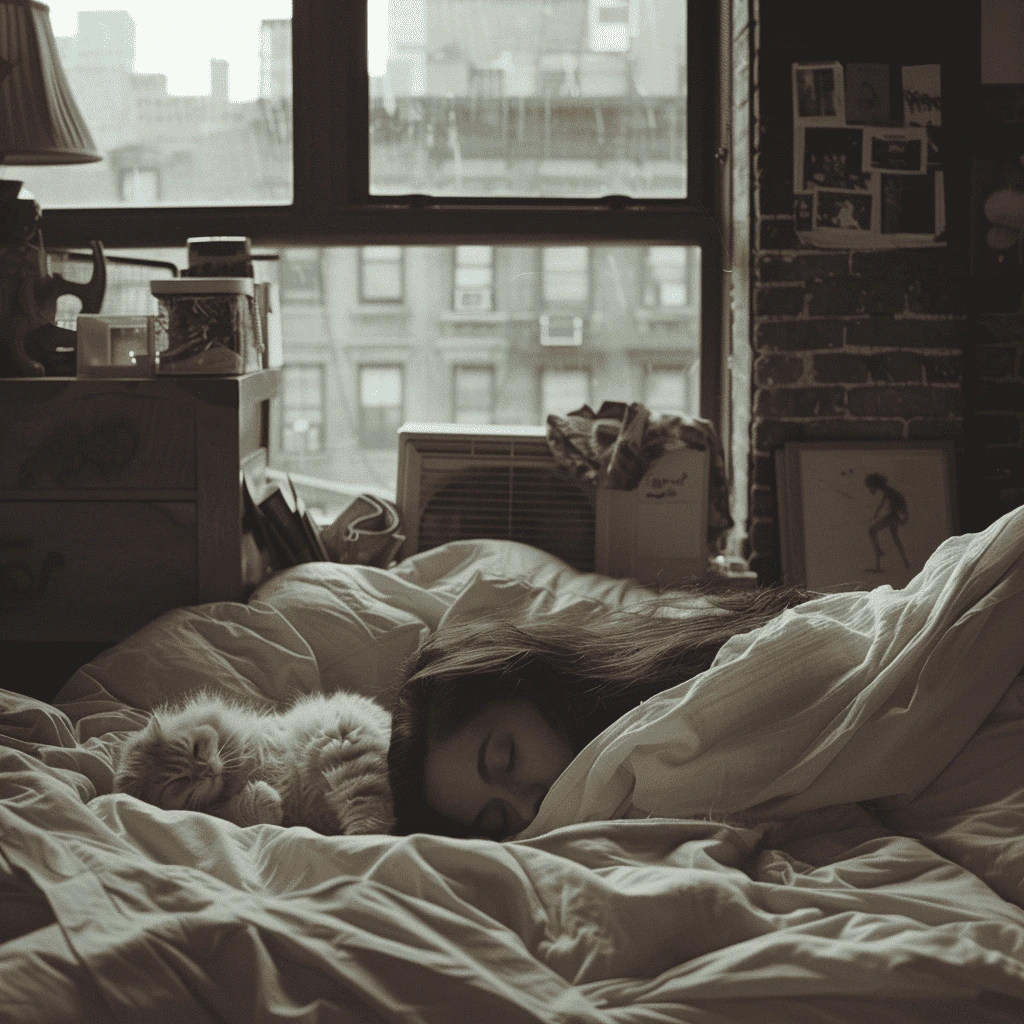Is Menopause Disrupting Your Life? Those relentless hot flashes, endless sleepless nights, and frustrating weight gain can feel overwhelming. Just when life should be settling into a comfortable rhythm, we’re confronted with this challenging biological reality.
While menopause affects women most directly (men experience andropause, but that’s a topic for another day), the impact of its symptoms becomes truly unbearable when combined with sleep deprivation. Without proper rest, every aspect of daily life becomes magnified—small irritations transform into major obstacles, and emotions swing wildly out of proportion.
The truth is simple yet profound: quality sleep colors everything else in our lives. When sleep suffers during menopause, everything else suffers too.
Table of Contents
What is Quality Sleep During Menopause
For women navigating perimenopause and menopause, quality sleep isn’t just about duration—it’s about achieving consistent deep and REM sleep cycles without hormonal disruptions. Science shows that good sleep during this transition means uninterrupted rest with minimal night sweats, maintaining a body temperature conducive to sleep (typically dropping 1-2°F at night), and completing 4-5 full 90-minute sleep cycles. When these elements align, women experience restored cognitive function, balanced mood regulation, and the cellular repair essential for managing hormonal fluctuations, creating a foundation for both daily wellbeing and long-term health during this significant life transition.
Understanding Menopause Sleep Challenges
Let’s talk about what’s really happening to your sleep during menopause. Those hormonal roller coasters aren’t just affecting your mood—they’re directly messing with your sleep patterns when estrogen and progesterone take a dive.
- Hot Flashes & Night Sweats: Those sudden heat waves that jolt you awake (sometimes 3-4 times nightly!) happen when your brain’s temperature control center gets confused by dropping hormone levels. Research shows about 75% of menopausal women experience these sleep-disrupting events.
- Heightened Anxiety: Your brain’s GABA receptors—the ones that help you chill out—are actually influenced by estrogen. When estrogen drops, your natural calm-down system doesn’t work as efficiently, making bedtime anxiety more common.
- True Insomnia: Studies show up to 60% of menopausal women struggle with clinically significant insomnia, taking 30+ minutes to fall asleep or spending hours awake in the middle of the night.
- Sleep Fragmentation: Your sleep becomes naturally lighter and more easily disrupted during menopause. Brain wave studies show women in this phase experience 30% more micro-awakenings than premenopausal women, even when they don’t remember waking up.
- Restless Legs Syndrome: That crawly, tingly sensation affects about 15% of women during menopause, triple the rate of younger women. The iron fluctuations and dopamine changes during this transition make RLS more likely.
- Disrupted Sleep Architecture: Your sleep cycles actually change shape during menopause. EEG studies reveal you get about 25% less deep sleep (the most restorative kind) and more time in lighter sleep stages that don’t refresh you as much.
The good news? Understanding these changes is the first step toward fixing them. Your body isn’t broken—it’s just navigating a major transition, and there are practical ways to help it adjust and get back to restful nights.
Creating a Sleep-Friendly Environment:
To enjoy your best sleep, it is essential to view your new sleep ritual as a luxurious new norm. Introducing simple edits and mindful practices to your boudoir could entice higher-quality and longer-lasting sleep.
Keep Your Cool: Creating the Perfect Sleep Temperature
Temperature isn’t just a comfort issue during menopause—it’s a sleep science essential. The ideal bedroom temperature for restorative sleep is between 60-67°F (15-19°C), which helps trigger your body’s natural sleep onset process. Open a window for fresh air circulation or position a fan strategically to maintain this sleep-friendly zone. Ditch those flannel pajamas for lightweight, breathable sleepwear—or sleep in your underwear if that’s comfortable. Your skin needs to breathe during those hormonal temperature fluctuations.
Regarding bedding, high-quality 100% cotton sheets with a 300-400 thread count offer the perfect balance of comfort and breathability. Synthetic fabrics trap heat against your body, while natural fibers allow heat to dissipate. Consider switching from a heavy comforter to a lighter blanket or an empty duvet cover on particularly warm nights.
A brief cool shower before bed can lower your core temperature, signaling to your brain that it’s time for sleep—just be sure to dry your hair thoroughly, as wet hair can disturb your sleep later.
Set the Mood: Creating Your Sleep Sanctuary
The environment around you plays just as crucial a role in quality sleep as temperature. Your brain relies on specific sensory cues to trigger its natural sleep cycle, especially during menopause, when sleep is more fragile. In the name of self-love, romance yourself to sleep, get out the quiet time music, journal before bedtime, give yourself a little self-massage with some lavender essential oil, and turn the lights out.
Manage Light for Optimal Melatonin
Gradually dim your lights in the evening hours to signal your brain to start melatonin production. Those bright screens from phones, tablets, and TVs emit sleep-disrupting blue light that confuses your hormonal sleep signals. Switch to warm, amber lighting in the evening and establish a digital sunset at least 60 minutes before bedtime—your melatonin levels will thank you.
The Power of Complete Darkness
Research published in the Journal of Pineal Research shows that even minimal light exposure during sleep can reduce melatonin production by up to 50% and disrupt deep sleep phases. Blackout curtains create a truly dark environment that supports your circadian rhythm, particularly valuable during perimenopause when sleep is more easily disrupted. For a more portable solution, quality eye masks that contour to your face without pressure can block 99-100% of ambient light. Studies demonstrate that complete darkness increases time spent in REM sleep by approximately 15%, which is crucial for emotional regulation and cognitive processing during hormonal transitions.
Sound Management for Uninterrupted Sleep
Sound disruptions can fragment your already vulnerable sleep architecture. If environmental noise or a snoring partner keeps triggering those middle-of-the-night wake-ups, consider adding a white noise machine, comfortable earplugs, or soft background sounds that mask disruptive noises without demanding attention from your brain.
Supportive Sleep Surfaces Matter
Don’t underestimate the impact of your sleep surface. A mattress that correctly supports your changing body and maintains neutral alignment can reduce nighttime discomfort and movement. Many women find that memory foam or cooling gel mattress toppers provide pressure relief and temperature regulation, essential for menopausal sleep needs. Some find the plushness of a pillow-top mattress luxurious and to lie into for a yummy night of sleep.
These environmental adjustments complement your temperature strategies, creating a complete sensory experience that guides your body toward deeper, more restorative sleep phases.
Lifestyle Adjustments for Better Sleep:
- Sync Your Internal Clock
Consistency creates powerful sleep chemistry. Going to bed and waking up at the same times daily—even on weekends—stabilizes your circadian rhythm, which research shows becomes increasingly sensitive during hormonal transitions. This regularity helps maintain predictable cortisol and melatonin cycles, hormones that often fluctuate erratically during menopause.
Establish a 20-30 minute wind-down ritual that your brain learns to associate with sleep onset. Whether it’s gentle stretching, reading something peaceful (not on a screen), or practicing 4-7-8 breathing (inhale for 4, hold for 7, exhale for 8), these activities activate your parasympathetic nervous system. This “rest and digest” mode counterbalances the stress response that often intensifies during menopause, gradually lowering your heart rate and preparing your body for deep, restorative sleep phases.
- Nourish Your Sleep Cycle
What you consume directly impacts your menopausal sleep quality. Due to changing liver enzyme activity, caffeine’s half-life extends to 7+ hours during perimenopause, meaning that 2 p.m. coffee can still disrupt your sleep at midnight. Scale back on caffeine after 12 p.m., and be mindful of hidden sources in chocolate, teas, and certain medications.
While alcohol might initially make you drowsy, research shows it fragments sleep architecture, particularly in women with changing estrogen levels. That evening glass of wine increases hot flashes by up to 33% and dramatically reduces deep sleep cycles when your brain needs them most. Consider alcohol-free evenings at least 4 nights weekly to experience actual restorative sleep.
Evening meals matter tremendously. Heavy, spicy, or high-fat dinners increase core body temperature during digestion, potentially triggering night sweats. Opt for lighter protein-carb combinations like turkey with sweet potato or salmon with quinoa at least 3 hours before bed. These provide the tryptophan and complex carbs your brain needs to synthesize sleep-inducing serotonin without the metabolic heat of larger meals. Stay well-hydrated throughout the day, but taper off 90 minutes before sleep to reduce those frustrating middle-of-the-night bathroom trips that fragment your precious sleep cycles.
- Calibrate Your Movement for Sleep Success
Physical activity powerfully regulates your sleep-wake cycle, but timing matters profoundly during menopause. Morning exercise—particularly outdoors—serves double duty: the natural light exposure helps reset your circadian rhythm while the activity itself reduces sleep-disrupting cortisol levels by approximately 25% for the following night.
Research in the Journal of Sleep Medicine shows that women experiencing menopausal transition who engage in 30 minutes of moderate aerobic activity 4-5 times weekly report 65% improvement in sleep quality and 40% reduction in night sweats. However, the timing window matters significantly—intense exercise raises core body temperature by 2-3°F for up to 4 hours afterward, potentially triggering those frustrating hot flashes that fragment sleep.
Schedule vigorous workouts before 2pm when possible. For evening movement, opt instead for gentle, cooling practices like yin yoga or mindful stretching that activate your parasympathetic nervous system. A systematic review of 17 clinical studies found that slow, restorative evening yoga reduced sleep onset time by an average of 15 minutes and increased total sleep time by nearly 45 minutes in menopausal women.
The sweet spot? Morning cardio or strength training for hormonal regulation, and evening gentle movement that prepares your nervous system for the deep rest your changing body craves.
- Rewire Your Stress Response for Deeper Sleep
The hormonal shifts of menopause amplify your body’s stress reactivity precisely when you need calm for sleep. Modern neuroscience reveals why targeted relaxation practices aren’t just nice-to-have—they’re biological necessities during this transition.
A landmark study in the Journal of Clinical Endocrinology found that just 10 minutes of diaphragmatic breathing before bed reduced cortisol levels by up to 30% in menopausal women. This simple practice—breathing deeply into your belly rather than your chest—activates the vagus nerve, your body’s built-in “relaxation switch” that becomes less responsive as estrogen declines.
Mindfulness meditation specifically addresses the racing thoughts that plague 78% of women during perimenopause. Brain imaging studies demonstrate that regular practitioners show increased activity in the prefrontal cortex while decreasing reactivity in the amygdala—literally retraining your brain’s stress circuitry. Start with just 5 minutes using a guided app, gradually building to 15-20 minutes for maximum sleep benefits.
Restorative yoga poses like Legs-Up-The-Wall or Supported Child’s Pose trigger what researchers call the “relaxation response,” measurably lowering blood pressure and heart rate within minutes—counteracting the exact physiological arousal that keeps you staring at the ceiling at 2am.
For cognitive overwhelm, try the “brain dump” technique: spend 10 minutes before bed transferring all racing thoughts onto paper. This simple practice has been shown to decrease sleep onset time by 37% by literally offloading mental activity from your brain’s working memory centers. Your worries will still be there tomorrow—but captured on paper, they lose their power to hijack your precious sleep.
- Strategic Power Pauses: The Nap Science for Menopause
The midday energy crash hits differently during menopause, but approaching naps strategically can energize your days without sabotaging your nights. Sleep researchers have identified the ideal “nap zone” specifically for women navigating hormonal transitions.
During perimenopause and beyond, your brain’s sleep pressure—the biological drive for rest—builds more erratically throughout the day due to fluctuating hormone levels. According to research from the Sleep Medicine Center, a properly timed 20-minute power nap between 1 and 3 p.m. works with your natural circadian dip to boost alertness by 54% while enhancing problem-solving abilities by nearly 40%.
However, the 30-minute threshold is crucial. Studies show that extending beyond this timeframe pulls you into deeper sleep stages, triggering “sleep inertia”—that groggy, disoriented feeling that can persist for hours. Even more problematic for menopausal women, naps longer than 30 minutes can decrease your brain’s adenosine levels (the compound that builds sleep pressure), potentially reducing your ability to fall asleep that night by up to 72 minutes.
Location matters too. Napping in bed sends confusing signals to your brain about sleep environments. Instead, use a comfortable chair or sofa in a slightly cooler room (68-70°F) to prevent the hot flashes often accompanying horizontal rest periods.
For those days when exhaustion hits hard, remember this rule of diminishing returns: a 10-minute nap provides nearly 85% of the cognitive benefits of more extended rest periods without disrupting your nighttime sleep architecture. Your brain doesn’t need more time—it requires the right timing.
Nature’s Sleep Chemistry: Evidence-Based Remedies for Hormonal Nights
The estrogen decline of menopause directly messes with your brain’s sleep switches. While prescription options exist, research has uncovered specific natural compounds that target your unique sleep challenges.
Precision-Timed Botanicals
Certain herbs work with your brain’s GABA receptors—the same ones thrown off by hormonal changes. Studies show valerian root (300-600mg) taken an hour before bed boosts deep sleep by 36% in perimenopausal women. It’s not just calming like chamomile—it actually fixes the brain chemicals disrupted during this transition.
For those 3AM wake-ups, lemon balm works surprisingly well. Recent research found it cut nighttime awakenings by 42% without the morning brain fog of sleep meds.
Mineral Gaps That Sabotage Sleep
Three-quarters of menopausal women lack sufficient magnesium, yet this mineral drives hundreds of sleep-regulating reactions. Form matters: magnesium glycinate (300-400mg) absorbs better without the digestive issues, crossing into your brain to help regulate sleep signals.
Calcium pairs with magnesium in a 2:1 ratio, helping specifically with sleep continuity—addressing those frustrating frequent wake-ups.
Melatonin Misconceptions
Your melatonin production doesn’t necessarily drop during menopause—its timing just gets weird. Tiny doses (0.5-1mg, not the mega-doses on store shelves) help reset your clock without suppressing natural production. Time-release formulas work better for maintaining sleep all night.
Use melatonin as a reset tool, not a forever solution. Try a 3-week cycle followed by a week off to prevent your brain from adapting.
Aromatherapy That Actually Works
Your nose provides a direct pathway to your brain’s emotional center. Lavender contains compounds proven to increase deep sleep in brain wave studies. Real research shows inhaled lavender cuts time to fall asleep by 19 minutes during menopause. Vetiver and clary sage also deliver, with clary sage specifically influencing estrogen receptors. Diffused before bedtime, they measurably lower stress hormones better than synthetic scents.
When It’s Time for Professional Backup
If you’ve given these strategies an honest shot for a few weeks and you’re still staring at the ceiling all night, it’s time to bring in reinforcement.
Sleep issues can signal hidden problems like sleep apnea (surprisingly common in menopausal women) or thyroid imbalances that need proper testing. Don’t brush off ongoing exhaustion as “just menopause”—quality sleep is non-negotiable for your health.
For severe sleep-disrupting hot flashes, low-dose hormone therapy (HRT) remains the gold standard, cutting night sweats by up to 80%. Bioidentical progesterone specifically targets sleep architecture, helping you maintain those crucial deep sleep stages. Not ready for prescriptions? Some women find relief with phytoestrogens like red clover or black cohosh, though they’re typically less potent than medical options.
The bottom line: there’s no medal for suffering through sleep deprivation. Whether you choose conventional medicine, natural alternatives, or a thoughtful combination, getting proper support for your sleep is a game-changer for navigating this transition.

Your Sleep Breakthrough: Beyond Menopause Nights:
Look, menopause throws some serious curveballs at your sleep, but you’ve got more power here than you might think. The science is clear—small, strategic changes to your bedroom setup, daily routines, and even pajama choices can dramatically reduce those middle-of-the-night wake-ups.
Your body is going through a natural transition—not a malfunction—and you don’t have to surrender to the 3 AM ceiling-staring club. Research shows that women who implement targeted sleep strategies during menopause report up to 60% improvement in sleep quality within just 2-3 weeks of consistent practice.
This isn’t about perfect sleep every night (let’s be real). It’s about building a personalized sleep toolkit that works with your changing hormones rather than fighting against them. With some experimenting and patience, you can reclaim those deep, refreshing nights that leave you feeling like yourself again.
The journey back to restful sleep might take some tweaking, but thousands of women have found their way—and you will too. Sweet dreams aren’t just possible; with these approaches, they’re inevitable.

